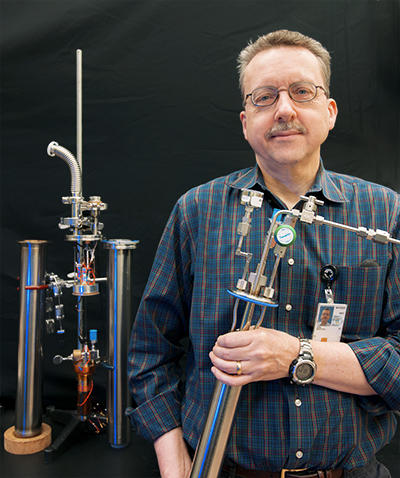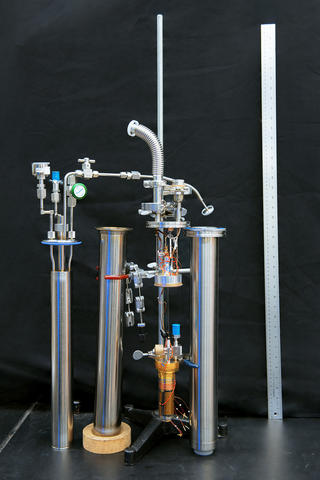
PML's Weston Tew with the new triple-point cells.
Elemental mercury – which is being phased out of commercial thermometers worldwide due to safety concerns – may also be replaced as a temperature reference material thanks to new efforts from NIST scientists who have been studying alternatives. One compound in particular, sulfur hexafluoride (SF6), is showing strong promise as a substitute.
The triple-point of mercury is one of the 16 defined temperature fixed points* that make up the International Temperature Scale of 1990 (ITS-90), an international standard extending from 0.65 K to approximately 1358 K (-458.5 to 1984.73 °F). Achieving the triple point, a unique temperature where solid, liquid, and gas phases coexist in equilibrium, involves cooling mercury in a specialized cell. State-of-the-art mercury cells can achieve uncertainties of less than 1 millikelvin (mK), making them excellent temperature references.
Increasing concern over the health and environmental hazards that mercury poses has resulted in strict regulation** of its sale and distribution, both within the U.S. and internationally. While mercury thermometers have largely been rendered obsolete by comparably accurate alternatives, there is currently no ready replacement for the mercury triple-point as a temperature reference in the range between 210 K and 240 K. This could soon lead to a bottleneck in thermometer calibrations as fewer and fewer labs are able to maintain a mercury cell.
"Since any thermometer calibration that goes below 0 °C makes use of the mercury triple-point, the development of alternative fixed points is imperative," explains Weston Tew of NIST's Physical Measurement Lab (PML), "and we at NIST can lead this effort by evaluating the most promising substitute materials."

Of a number of proposed substitutes, researchers have identified two likely candidates: carbon dioxide and SF6. Both are chemically inert, relatively inexpensive, and have triple-points just below that of mercury, which means they could serve as "drop-in" replacements with minimal adjustment to the ITS scale. However, both materials require extensive experimentation to determine their practicality as replacements.
NIST scientists are currently focusing on sulfur hexafluoride, developing the first ever SF6 triple-point cell designed for use in temperature calibration. The SF6 triple-point (~233.555 K) offers some unique challenges: The cell must operate at higher pressure than any other triple point, and it would be the first fixed point made from a compound that is produced by chemical synthesis, which means it is more difficult to get extremely pure samples. To achieve performance on par with mercury, it is likely that an order-of-magnitude better purity is needed than what is typically available commercially, with impurities forming less than one-millionth of the sample material.
Initial results from several different SF6 cells have been promising. Using smaller cells and an ultra high-purity gas source, the researchers have achieved a melting range of ~1 mK, the necessary level for comparing favorably with mercury cells. However, the larger immersion-type cells – those used in ITS-90 calibrations – present some greater technical challenges. At the moment, preliminary data indicate melting ranges of a few millikelvin.
Tew notes this is still early work, and explains that "after you have high enough chemical purity, and your equipment is good enough, all that remains is improving the technique." Ultimately, further refinement of cell designs and technique will determine the feasibility of SF6 replacing mercury as a temperature reference.
—Sean Kelley
* These points are mostly based on phase changes, and are defined to be at specific temperatures, which provides a fixed reference for calibrating Standard Platinum Resistance Thermometers (SPRTs). Other points include the freezing point of aluminum and the triple point of water, which is used to define the kelvin.
** For instance, the Mercury Export Ban Act (MEBA) of 2008 prohibits federal agencies from selling or distributing elemental mercury.

